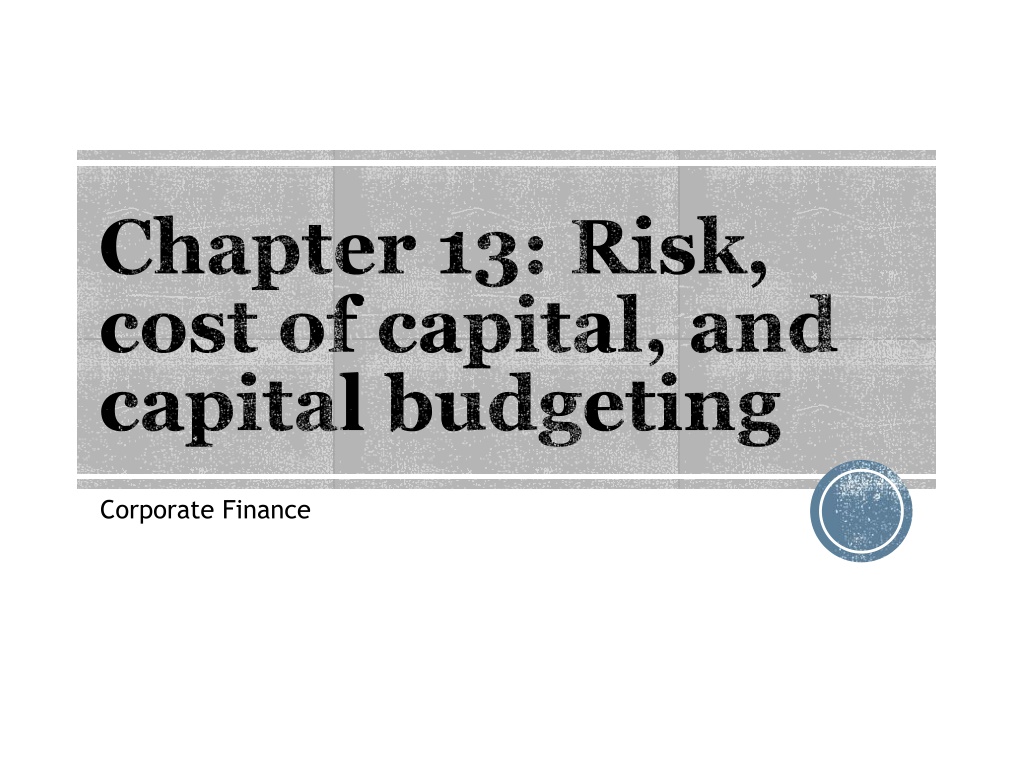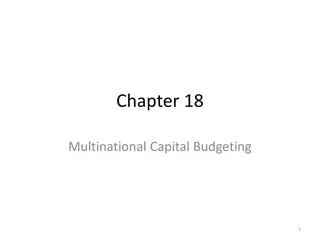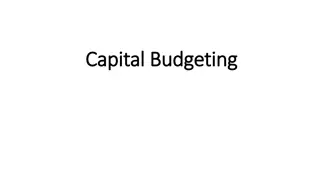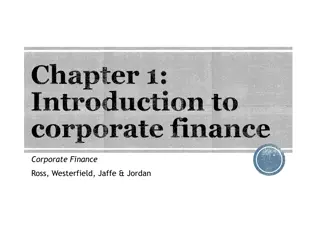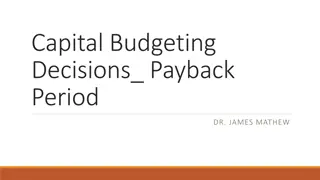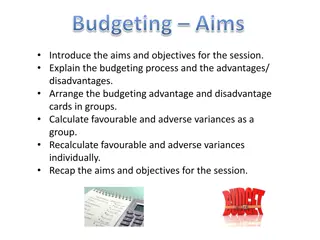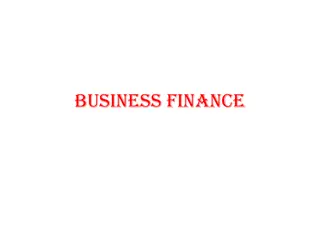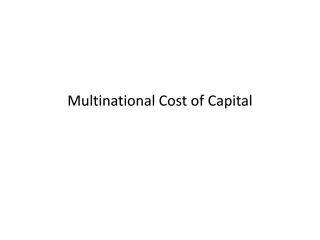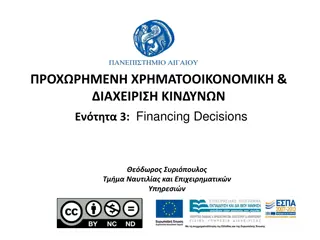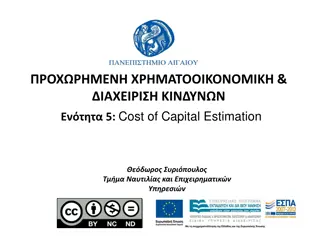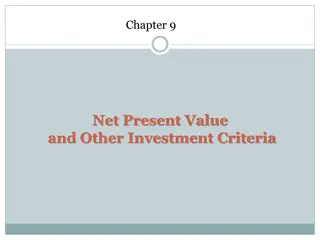Understanding Risk, Cost of Capital, and Capital Budgeting in Corporate Finance
Explore the concepts of risk, cost of capital, and capital budgeting in corporate finance, including the Capital Asset Pricing Model (CAPM), cost of equity, beta estimation, and cost of capital. Learn how to reduce the cost of capital and understand the impact of reducing the Weighted Average Cost of Capital (WACC) on a project's Net Present Value (NPV) estimate.
Download Presentation

Please find below an Image/Link to download the presentation.
The content on the website is provided AS IS for your information and personal use only. It may not be sold, licensed, or shared on other websites without obtaining consent from the author. Download presentation by click this link. If you encounter any issues during the download, it is possible that the publisher has removed the file from their server.
E N D
Presentation Transcript
Chapter 13: Risk, cost of capital, and capital budgeting Corporate Finance
Outline 1. The CAPM and the cost of equity 2. The cost of capital 3. Reducing the cost of capital
The cost of equity In Chapter 11, we learned that the CAPM provides an estimate of the required (expected) return from stock market (equity) investors perspective. We learned that this required return can be used to estimate the cost of equity. The cost of equity is a positive function of beta.
Beta estimate, I In Chapter 11, we also learned that we can estimate the beta of a firm by regressing the excess returns (the difference between the stock s returns and the risk-free rates) of the firm on the excess returns of a market index, such as the S&P 500 Index. The slope term is the firm s beta estimate. We usually use most recent 60 monthly returns for this estimation. Of course, we can find the beta estimate from many internet sites as well, e.g., finance.yahoo.com.
Beta estimate, II The word estimate of course says something about the uncertain nature of the beta estimate; it is subject to estimation error. As a result, some practitioners like to use the industry s average beta as a proxy for the firm s beta as well, even though the firm s beta can be directly estimated. If you believe the operations of the firm are similar to the operations of the rest of the industry, it is a good idea to use the industry s average beta to reduce estimation error. If not, then use the firm s beta estimate for calculating the cost of equity.
Cost of capital For corporate capital budgeting purpose, we often discount a project s free cash flows (to the firm) by its cost of capital. Free cash flows (FCFs): the cash flows available to the firm s suppliers of capital, including debt and equity, after all operating expenses (including taxes) have been paid and investments in working capital and fixed assets have been made. Firm = debt + equity.
Question Holding all else constant, what would happen to a project s NPV estimate if its WACC is reduced?
WACC, I Because FCFs are available to debt-holders and equity-holders, the applicable discount rate needs to be an aggregate of the cost of debt and the cost of equity. The most popular choice of this applicable discount rate is called WACC (weighted average cost of capital). WACC is a function of the cost of debt and the cost of equity.
WACC, II WACC = we re+ wd rd (1 corporate tax rate). reis the cost of equity (via the CAPM or other pricing models). re = E(ri) = rf+ i (E(rm) rf). rdis the cost of debt; if the firm uses corporate bonds to finance all of its long-term debt, we can use YTM as an estimate of the cost of debt.
WACC, III weis the capital structure weight of equity. wdis the capital structure weight of debt. E is the market value of equity; D is the market value of debt. we= E / (E + D), and wd= D / (E + D).
Weighted cost of debt, I A corporation may have multiple issues of bonds outstanding. rdis often the weighted average of YTMs of many issues. The weights can be market value weights or book value weights.
Weighted cost of debt, II Example: DEF Inc. has 2 issues of bonds outstanding. Bond A has a book value of 100 million, market value of 120 million, and a YTM of 5%. Bond B has a book value of 200 million, market value of 180 million, and a YTM of 5.5%. Book value weight: rd= [100/(100+200)] * 5% + [200/(100+200)] *5.5% = 5.34%. Market value weight: rd= [120/(120+180)] * 5% + [180/(120+180)] *5.5% = 5.30%.
WACC example The market capitalization of EMN is $3.947 billion. EMN use corporate bonds as the main source of L-T debt. The market value of bonds is $1.519 billion. The weighted average of YTMs is 6.2%. The beta of EMN is 0.8. The risk-free rate is 4.26%. The expected market premium is 8.7%. The corporate tax rate is 35%. re= 4.26% + 0.8 8.7% = 11.22%. we= 3.947 / (3.947 + 1.519) = 72%. wd= 28%. WACC = 0.72 11.22% + 0.28 6.2% (1 0.35) = 9.21%.
WACC on the web www.valuepro.net.
A sample question The WACC is used to _______ the expected cash flows when the firm has ____________ . a. discount; debt and equity in the capital structure b. discount; short term financing on the balance sheet c. increase; debt and equity in the capital structure d. decrease; short term financing on the balance sheet e. None of the above.
Reducing cost of capital At the national level: (1) Better develop capital markets such that cost of debt, rd, and/or market risk premium, E(rm) rf, (and thus cost of equity, re) is reduced. (2) Reduce political risk such that market risk premium, E(rm) rf, is reduced.
Political risk in China The stock price for Gaotu, formerly GSX Techedu, has dropped this year to US$2.50 from US$149 amid controversies, fines and new regulations. Beijing s ban on profits for K-12 private online tutoring firms has upended the industry, causing a sell-off that has spread to other Chinese tech stocks. China s government has now shown that it is not afraid to simply shut down a large and profitable industry in order to achieve its social and political goals Source:SCMP , 07/2021
Reducing cost of capital At the firm level: (1) Raising equity in a nation where cost of equity is lower (i.e., where you can sell your shares at a higher price). (2) Raising debt in a nation where cost of debt is lower. (3) Improve corporate governance and transparency such that investors perception toward the risk profile of your firm is more favorable. The idea is that a lower perceived level of investment risk leads to a lower level cost of capital, and thus higher levels of NPVs and a higher firm value and stock price.
Mini-case report due Please submit your report for mini-case: The Cost of Capital for Swan Motors, pp. 426-427, in 1 week. Work on problems 1, 2, 4 (using only market value weights), and 5 (using only market value weights).
End-of-chapter Concept questions: 1-10. Questions and problems: 1-13 (excluding book-weight (sub- )problems).
